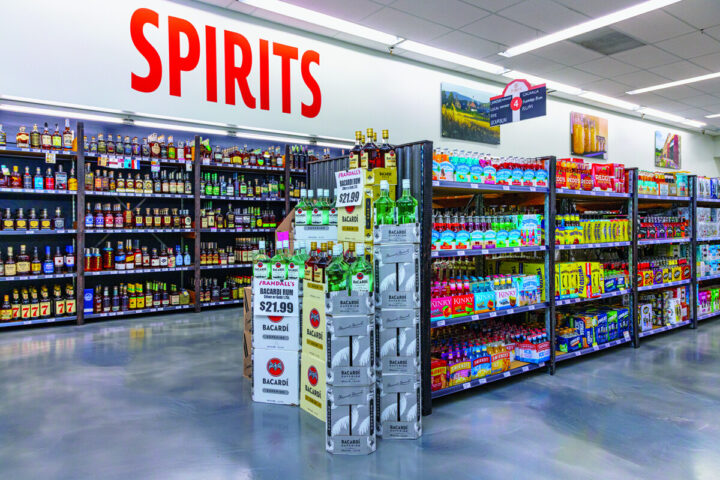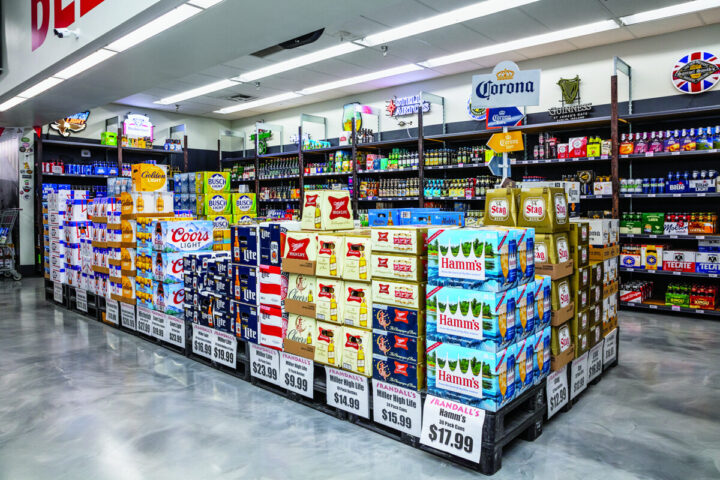
Todd Randall runs his off-premise stores with an on-premise mentality. As vice president of the five-unit Randall’s Wines and Spirits chain of beverage alcohol stores in Missouri and Illinois, Randall says standing out in a highly competitive retail landscape requires much more than a wide selection, conveniently stacked. “You have to run your retail location with on-premise thinking, with marketing, promotions, and ideas that create a great experience,” he says. “People come to your store for the experience. If people just want a bottle, they’re going to grab it when they’re buying their hot dogs, but if they actually want an experience they’re going to go to an independent. We want to make it fun, a destination. I want everyone to feel like it’s a candy store when they walk through the door.”
Randall joined the family business—which his father, George, founded in 1998—in 2014 after a short stint as a financial analyst. “I learned that maybe the corporate lifestyle wasn’t best suited for me,” he says. “I like being on the go a little bit more, ad hoc stuff, trying to solve problems. It’s more enticing to me to be working directly with people, not stuck in a cubicle or by the computer.”
Of course, being the son of a retailer meant he was exposed to the business early on. “I’ve always been around it, doing whatever I could do legally, whether it was taking out the trash or cleaning up” as a younger teen, he recalls. Then during college, Randall says his father “always knew he had a part-time employee on call at all times.”
When he moved back to Missouri in 2014 and began training to take over, he started by learning from the ground up. “I wasn’t as involved in running the stores as much as I am today,” Randall says. “It was purely just me helping fill shifts and working as kind of an assistant manager at one of the stores. I just became part of the team, whatever I had to do to help out.”
Randall says his father—who was named a Market Watch Leader in 2007 and was recognized again in 2010 with a Best Website Award—is still involved in the business but not on a day-to-day basis. “It’s still nice to have him at times for consulting purposes or pick his brain,” he says. “I don’t think you ever have too many people to feed off of—more information is always better.”
Now, Randall is putting his own stamp on the chain, which consists of four stores in Missouri and one in Illinois, all in the St. Louis metropolitan area. Four of the stores are long-term players while the fifth was added about 18 months ago. The units range in size from 8,000-22,000 square feet, and the goal for all is to carry as large a selection as possible while honing in on regional preferences, and to create a memorable experience in the process.
For creating a vibrant customer experience, along with offering a broad selection and stellar service, Randall has been named a 2023 Market Watch Leader.

Creating The Experience
Randall is convinced that differentiating the experience for the customer is a key to success, making Randall’s stores competitive with the big box chains. “I just think there’s something about the experience,” he says. “When people show up, we want them to have a great time, have some samplings, see some cool displays, and have access to different items on the shelf than they see at Costco or Sam’s Club or any of the big box stores. That’s what they come in for.”
There’s nothing “typical” about his customer base, Randall adds. “My customer is everyone,” he says. “People who are coming in are generally in a great mood, so we want to bounce off that energy, make it better, and have a great time.” Part of that great time can be had through tastings and educational seminars, which have ramped up in the post-pandemic environment. “We’ve been doing seminars left and right, and it’s been a success so far,” Randall says. “Due to the breadth of products available and due to customers trying to truly understand what they’re consuming, they want the education, they want the backstory and they want to know how it’s made.”
Randall relies heavily on his floor staff to execute his vision for the optimal customer experience. “I put it in their court,” he says, noting that applies to the selection as well as the experience. “They’re the ones at the store all the time. I still think they’re more important than I am. Our customers are the most important, but I think our cashiers are our second-most important people in the store because they 100% have an interaction with every single person. They’re involved, they’re excited, they taste the new items, they get behind them, and often they start telling customers what they drank last night and why they liked it. It’s not rocket science, people come in, you give them a great experience, you treat them how you want to be treated, you help them find whatever it is they’re looking for, and then they’re done.”
That is perhaps why Randall is more enthused about in-store sales than online transactions. Online was a focal point in the early and mid-2000s, recalls operations manager Jase Bennett. Bennett has been with the Randall’s organization since 1999 and remembers the evolution of the company. “Our goal was always to do something that no one else was doing, or no one else was doing well, and find ways to innovate and grow ourselves in an already crowded market,” he says, noting the early days when the focus was selling wine online.
“We have some personal goals to grow [the online business], but I don’t think we’re looking at that side for exponential growth,” Bennett continues. “People are now saying everything is going online. Well, we were there—been there, done that, and we’re still doing a fair amount of it.” He notes the online channel is now heavily price-focused and highly competitive. “It used to be everything was online and the retail was sort of a sideline. It’s kind of the other way now, so we can be more people focused,” he says.
Delivery is also part of the equation. Not surprisingly, that ramped up during the Covid-19 pandemic. It remains more robust than it was in 2018 and 2019, but it’s no longer a major focus, Randall says. He calls delivery “a nice added value for the customers who want it,” but is convinced that offering the personal, in-store experience is the right path for continued success.

Curating The Selection
Randall’s policy on the selection of beverage alcohol in his stores is democratic. “I think we try to carry just about everything we can get our hands on, but also within reason,” he says. These days, with the growth of spirits over the past several years, they now account for about 50% of sales. Wine and beer/seltzers each account for about 20%, and the remaining 10% is non-alcoholic drinks and accessories.
His openness to “everything” comes with a few safeguards. In any given category, there are limits to the number of brands that are going to gain traction. Randall and his team try to anticipate the demand and stock accordingly. “It’s part of our job and our responsibility to curate the best selection for the customer,” he says. “It may not always be the biggest, but it’s the best selection of brands that we like, that we want to get behind, that we think is a good buy for the consumer. Or if it’s what the consumer wants, we’ll obviously stock it. It’s a lot of trial and error.”
Randall’s has enough buying power and industry clout to get some of the highly allocated wines and whiskeys that are a draw to consumers. How those are then shared with customers runs the gamut. “A lot of times we’ll just put them on the shelves, and sometimes we won’t post about it on social media, sometimes we will,” Randall says. “Sometimes we email our VIP list, which is around 80,000-85,000 currently. We donate to charities. We’ve tried a little bit of everything because there’s no perfect way.”
In addition to those items, Randall says the brand categories that resonate most with consumers shift from year to year. Right now, Tequila is the hottest category in spirits, seltzers are hanging tough, and RTDs are growing rapidly. On the wine side, sparkling wines of all types and “fun whites and fun reds” are also in high demand.
“Things like orange wine, natural wines, other varietals, especially Italian—Gavi or Pecorino—or other varietals like Albariño and Vinho Verde,” Randall says. “Those are, to me, the fun wines to sample in the store because people [aren’t as familiar with them]. Those are the things I think get people excited.”
The Randall family also owns an importing business, which targets smaller wineries with something unique to offer. “We can find great family-run winery products, import them ourselves, and offer a fantastic product for a great price for the consumer,” Randall says.

Planning The Future
The Randall’s chain generated sales of more than $20 million in 2022. Randall says the stores have clawed back business that was lost to competition. Specifically, Total Wine & More entered the market in 2016, which took a toll on the bottom line. But years of building back—coupled with increasing consumer embrace of independent operators that accelerated during the pandemic—has put the chain in a solid financial position moving forward.
Expansion isn’t off the table, although Randall says there are no active plans in the works. Operating in Illinois is a bit more challenging because it is a “deal state” while Missouri is a “case one state.” In a case one state, distributors are required to offer the same price to all retailers, regardless of size or purchasing power. In a deal state, those structures on price aren’t in place. “There’s so much going on that you really do feel like a stock trader, making sure you get in, get people’s attention, especially when you’re battling against all the other retailers for the same product and the quantity of those products,” he says. “You’ve got to be on it all the time.”
That said, the more challenging environment in Illinois isn’t putting Randall off expansion in either state. Instead, his concern lies in proximity. “It’s been nice having all our stores about 30 minutes away [from each other],” Randall says. “I don’t want to lose control and put forth a bad product that I can’t maintain to a high standard just because we want to expand.”
Any expansion will likely be in one of those two states, Randall adds, noting that there are beverage alcohol marketing restrictions that differ between the two states, in addition to the purchasing differences. “After dealing with Illinois and Missouri, I couldn’t imagine throwing a third state in the mix,” he says. “There are drastic differences and if you’re not on top of it, you might overlook something.”
For now, Randall says he’s thrilled with the status quo. “I enjoy what I’m doing, I enjoy the people, and I love the industry we’re in,” he says. “Customers are happy, and so are our employees. I don’t know quite how the future will look but I’m enjoying what I’m doing right now.”